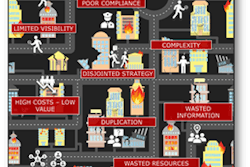
Procurement teams within businesses of all sizes are under pressure to drive, and then demonstrate measurable value and savings. Many are choosing to automate and optimize part of or all their finance and procurement operations as part of that process. However, like any other investment, procurement pros need to justify the investment to their CFO or finance team for such an initiative.
In this series of articles, I will look at the key benefits of purchasing and invoicing automation and offer you some tips for building your own business case for wider investment. By following the right steps procurement teams can help their organization can go from $0 to at least $250K a year in savings, so I will take you through the whole process of fleshing out those savings.
I will guide you through planning and producing a compelling business case for your source or procure to pay process re-vamp. Focusing in on how I see businesses traditionally approaching building a business case for finance and procurement optimization and automation and explaining why this can cause more problems than it solves. Demonstrating how you should be approaching this critical part of your organization's digital transformation to ensure you get it right and secure the buy-in you need.
Getting the scope right
Looking past your burning issue to review your whole source to pay process could help to unlock additional cost savings and business benefits that are far greater than just FTE savings, whilst also delivering more predictable results.
Do any of the following scenarios sound familiar?
- Your business finds a series of invoice duplication and data quality issues. This naturally leads you to look at how you can improve your invoice data entry processes and you end up paying for a new OCR platform to automate the data collection off your invoices. Sounds great? Except you’ve shelled out a lot of money to try and get more efficiency out of a broken process and you have ignored the root cause of your problem.
- A compliance audit highlights that your businesses spend is not pre-approved and that it needs to be rectified. This naturally leads you to look at how you can workflow purchase orders and you end up paying for a consultant to build out a purchase order workflow process in your SharePoint site. Problem solved? Not a chance, you’ve added a whole new workflow to your process without getting any downstream benefits of spend visibility, purchase order matching or budgetary checks.
- Your business identifies it has paid a fraudulent invoice. Your CEO and CFO are livid. You realise that the reason the invoice got paid was that there wasn’t a check in place to make sure that any bank account details match your master data records. This leads to your team changing your process to manually check bank records of each invoice. Risk averted? Not really, fraudulent invoices come in all different shapes and sizes and you’re only mitigating for one type of issue. Time and effort wasted.
These ‘compelling events’ are often the driving force behind most finance and procurement revamps. Whatever fire is burning brightest tends to determine what needs to be fixed. However, this sort of siloed, reactionary approach tends to drive a very limited scope, focused on just ‘fixing the immediate problem’. It’s widely accepted that a tactical and narrow scope only addresses the burning issue, which tends to result in missed cost saving opportunities and typically only provides FTE savings. This sort of approach can also start a whack-a-mole, domino effect of fixing one problem which, often, highlights another.
What organizations, indeed many procurement teams, tend to forget is that there is a huge amount of measurable value to be unlocked in your wider finance and procurement process. So why not use of the above compelling events as the trigger to review your whole source to pay process and an opportunity to drive huge cost savings and reduce your corporate risk profile.
A strategic scope that looks at the whole value chain will enable you to demonstrate the significant, measurable cost savings that could be achieved, while dramatically reducing the risk profile of your source to pay processes. Once you have defined the correct scope for any project, you need to review your existing processes to get a strong idea of what is working, what is not working and ultimately where the automation, optimization and cost saving opportunities are.
Understanding your existing processes
Processes do not exist in isolation, if you don’t understand all the aspects of the full value chain – what is working and not working – you won’t achieve any true optimization, automation, cost savings or risk profile reduction.
Businesses usually stick with a limited scope when they try to understand their existing processes. In the example we used above, where you’ve paid a fraudulent invoice because the bank account details were changed on the invoice, you might end up investing time in basic process mapping for checking bank details on your invoices, for example. Is process mapping alone sufficient? Is a tactical scope sufficient? No. This tends to lead to organizations realizing that the actual cause of the problem is not being addressed (albeit too late). So, you end up with a band-aid solution that only half fixes the problems you’ve identified.
The real levers that will drive return on your investment and drive internal/external user adoption are not understood and therefore not fully leveraged. This leads to new processes and/or systems not reaching what your business case promised and an ultimately guarantees poor user experience internally and externally.
How are process reviews typically done in businesses? Most often than not a tactical scope is mapped out with the output being basic process maps, which have limited detail on process exceptions that are causing the problems. Unfortunately, this usually means the source of a problem is not addressed and a detailed understanding of what will drive value and user adoption/change is not fully understood or realized.
I recommend conducting in-depth interviews with your key stakeholders to understand how your processes are working and what requirements your stakeholders have. If you understand the key pain points and levers to drive adoption, the areas that will drive a financial return on investment, any quick wins and long-term development areas, your business case will be far more compelling and harder to ignore.
Start by mapping out your processes and use the opportunity to go deeper across the whole value chain. Follow the process to its logical start and end points not just the part of the process that appears to be the most urgent. Interview key stakeholders and end users in the process to understand what is working well, what is not working well and what exceptions cause the biggest problems in terms of time and manual work.
From these interviews you should be able to gather key insights to questions such as:
- What are the key pain points in the process?
- What automation and process efficiencies will delight users?
- What user experience is needed to drive greater user adoption?
- What will drive return on investment? Where are the opportunities to reduce your cost of processing invoices, buying goods or negotiate greater cost savings across your supplier base?
- What would be the quick wins within your processes what will need to be a longer-term development?
- What cultural and team factors might impact your ability to change processes effectively?
- What different technology platforms are being used in your processes now?
All valuable insights that will help you to build your business case and answer many of the questions your executive team need to know before they agree to your project.
The rest of this series of articles will look at the equally important, next steps of mapping out your existing data and technology, mapping the future and ‘to be’ processes to implement, the technical ‘must haves’ of those processes, pulling together a transformation roadmap and a bottom-up value assessment.














